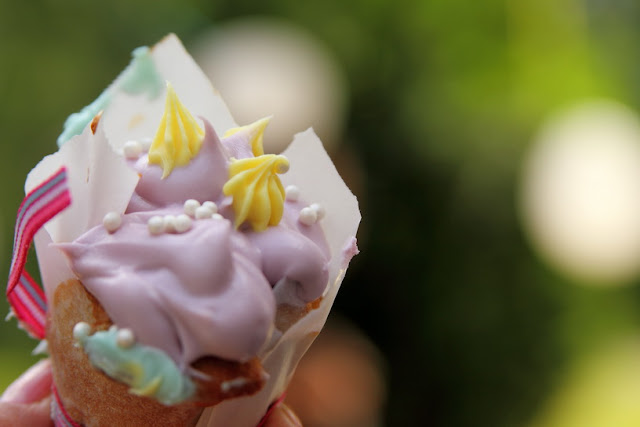I went out shooting Saturday to test the Tamron 28-75 1:2.8 lens. This fast shooter was a nice break and allowed for some shallow DOF and creative shots, as seen in the shots below.

ISO 125, f/4, 1/400
Cupcake and icing. This cupcake was about 2 inches across, shot at 70mm with a wide aperture created some nice blur and bokeh.

ISO 125, f/8, 1/100
Fruit bowl. Great colors and even with f/8, at 75mm the DOF is shallow enough to be creative.
The best feature of this lens is the constant aperture throughout the entire zoom range. F/2.8 is nicely fast, and allows a nice low light performance. It also allowed some creative shots that really emphasize DOF effects to highlight part of a scene.
The lens is lightweight, and focuses down to about 13 inches at all zooms. The zoom lock feature makes a nice addition for when you’re moving around with the camera pointing down. The filter size is 67mm, which is large enough to prevent vignetting unless you’re stacking filters and shooting at 28mm.
The lens does not rotate or extend while focusing, which simplifies the use of a CP. Rotating lens barrels often necessitate adjustment of your filter after focusing. The images were sharp through all focal lengths, even wide open. Where you focus will be tack sharp when used properly.
The big downside to this lens is the lack of image stabilization. This saves battery life, but has its own drawback. When you’re shooting handheld, you have to shoot faster than the reciprocal of your focal length. If your focal length is 50mm, than you have to shoot at 1/50 or faster. With an APS-C sized sensor, the focal length has to be multiplied by 1.6 to get the corrected number. For those with APS-C sensors, this means shooting no slower than 1/50 at 28mm. While this little champion performs well in low light, being limited to faster shutter speeds may be a drawback when shooting inside places without adequate illumination. Camera shake becomes very noticeable, even in smaller display sizes, at slow speeds and may lead to some seeming nice shots having to go into the dustbin.
Another drawback to the crop factor of the lens is DOF calculations. You will need to calculate based on the original focal length, not the cropped focal length. This can lead to a DOF you may not desire. This is usually not an issue, but could lead to shallower depth than you find desirable.
With most of today’s cameras capable of giving good performance at 1600 ISO, the lack of IS may not be an issue, but in a church or other extremely low light venue, not being able to handhold is a real setback. Overall, this lens is wonderful, especially in reasonable light. The image quality is spot on. There is no noticeable chromatic aberration, color reproduction is wonderful, sharpness is very fine, and there are no color shifts often seen with lesser lenses. Tamron makes some great stuff, they also make some lower end stuff, but this lens is one to get if you don’t mind the limitation in lower light. I didn’t get the chance to push it too hard, it’s not mine, but the little workout it received proved it a worthy addition.
On other issues, has anyone had the opportunity to get out and make some storm cloud magic? The weather has lifted bits here and there to allow some great photos to be made! Give it a try. Remember to meter for the entire range, and expose for the brightest parts you desire detail at M+2-M+3. You’ll be surprised at your magic!
My thanks to Darris for allowing me to test out this little giant of a lens. Here’s hoping everyone out there has a wonderful week and makes your photo dreams come true!
Is there anything you’d like to see here? Do you have a question? Share your thoughts here or at the Hohenfels Volks Facebook page. Of course, commenting on both Facebook and here is always appreciated, too! Don't forget, we're on Google+, too!
